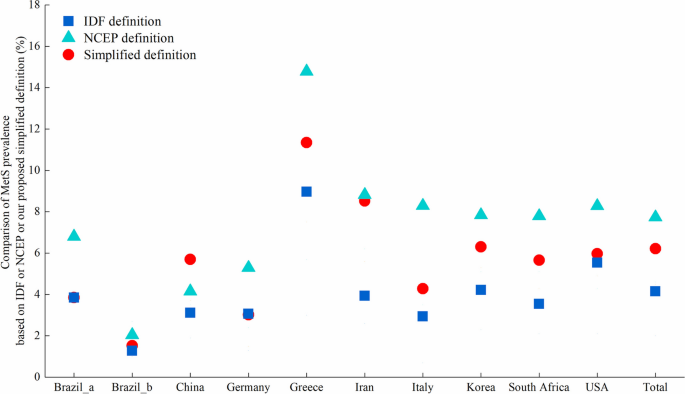The proposed simplified definition of pediatric MetS
The proposed simplified definition of MetS for children and adolescents aged 6–17 years was developed based on two widely used definitions of pediatric MetS (the IDF definition [11] and the NCEP definition) [15], with static cut-offs for defining all five components. The simplified definition defines MetS as the presence of three or more of the five components (i.e., central obesity, high BP, high triglycerides (TG), low high-density lipoprotein cholesterol (HDL-C), and high fasting blood glucose (FBG)) without specifying central obesity as an essential component. Of note, for either the IDF or NCEP definition, central obesity was defined as WC ≥ international age- and sex- specific 90th percentile values [16]. For the NCEP definition, high BP was defined as SBP/DBP ≥ international age-, sex- and height- specific 90th percentile values [17]. In the proposed simplified definition, we replaced age-, sex-, or height-specific percentile cut-offs of WC or SBP/BDP in the IDF or NCEP definition by simplified static cut-offs emerged from recent literature, and updated cut-offs for defining dyslipidemia and high fasting glucose. That is, central obesity was defined as WHtR ≥ 0.50 for youths from Europe and the USA and ≥ 0.46 for those from Asia, Africa, and South America [10]; high BP was defined as SBP/DBP ≥ 130/80 mm Hg for adolescents aged 13–17 years [13] and ≥ 120/80 mm Hg for children aged 6–12 years [12, 14]; high TG was defined as TG ≥ 130 mg/dl at age 10–17 years or ≥ 100 mg/dl at age 6–9 years [18], or low HDL-C as HDL-C < 40 mg/dl [11, 15]; and high FBG was defined as FBG ≥ 100 mg/dl [11, 19]. A comparison of cut-offs of five individual components for the simplified definition and the IDF and NCEP definitions is shown in Table 1.
Validation of the performance of the proposed simplified MetS definition in 10 pediatric populations
It should be noted that the IDF definition was recommended for youths aged 10–17 years and the NCEP was for those aged 12–19 years, but the proposed simplified definition is recommended for youths aged 6–17 years. In the following validation study, we just focused on the validation in adolescents aged 12–17 years for direct comparison with the IDF and NCEP definitions.
We firstly searched relevant studies on pediatric MetS or metabolic risk factors in PubMed database and we then invited the corresponding author of each study to participate in this work. Finally, individual data on metabolic risk factors globally, including 15 pediatric populations aged 6–18 years from Africa, Asia, Europe, North America and South Africa [10] were available for making the contribution. Overall, 19,426 adolescents (boys: 50.8%) aged 12–17 years, with complete data on sex, age, height, weight, WC, SBP, DBP, TG, HDL-C, and FBG, contributed to this present study. The characteristics of 10 pediatric populations from 9 countries (i.e., Brazil, China, Germany, Greece, Iran, Italy, Korea, South Africa, and the USA) have been described elsewhere [10]. In brief, the 10 study populations included six population-based cross-sectional surveys including eighteen public high schools in Northeastern Brazil (Brazil_a, 2012–2013), a community project (Estação Conhecimento) in Vitória, Brazil (Brazil_b, 2014–2016), a community-based Praeventions-Erziehungs-Programm (PEP) Family Heart Study in Germany (2000–2007), a survey in five schools in the Karlovassi province of Greece (2008–2010), a survey of eight primary schools in Calabria, Italy (2007–2008), and a school-based survey in South Africa (2007–2008), as well as four nationally representative surveys including the China Health and Nutrition Survey (CHNS, 2009), the Childhood and Adolescence Surveillance and Prevention of Adult Non-communicable Diseases in Iran (2011–2012), the Korean National Health and Nutrition Examination Surveys (2001–2013), and the US National Health and Nutrition Examination Surveys (NHANES, 2001–2018). WHtR was calculated as WC (cm)/height (cm). Each study received ethical approval from respective institutional review boards, and informed consent from the study participants and their parents/guardians.
We compared the prevalence of MetS across 10 pediatric populations by three definitions: the IDF definition, the NCEP definition and the simplified definition using the Chi-square test. The performance (accuracy) of the simplified definition in identifying MetS (yes vs no) using either IDF or NCEP definition as the gold standard was assessed by the receiver operating characteristic (ROC) curve analyses, with the calculation of area under the curve (AUC), sensitivity, specificity, positive predictive value (PPV), and negative predictive value (NPV). Generally, an AUC value < 0.7 is considered poor, 0.7–0.8 as acceptable and > 0.8 as good [24]. Basic data analyses were undertaken using SAS 9.4 (SAS Institute, Cary, NC). The ROC curve analyses were performed using reportROC 3.6 package running under R 4.2.2. Two-tailed P < 0.05 were considered statistical significance. As the IDF definition specified central obesity as an essential component, we also conducted additionally a sensitivity analysis to test if specifying central obesity as an essential component would alter the estimation of MetS prevalence by the simplified definition.
In general, the total MetS prevalence (6.2%) across 10 populations estimated by the simplified definition was roughly halfway between the prevalence estimated by the IDF (4.2%) and NCEP (7.7%) definitions (Fig. 1 and Additional file 1: Table S1&S2).
The ROC curve analyses showed that the total AUC (95% CI) of the simplified definition for identifying MetS in the 10 study populations achieved 0.91 (0.89–0.92) and 0.79 (0.78–0.81) when using the IDF or NCEF definition as the gold standard, respectively (Table 2).
Sensitivity analyses showed that the total MetS prevalence of 6.2% based on the simplified definition without central obesity as an essential component was slightly higher than that of 5.6% with central obesity as an essential component (Additional file 1: Table S3). This suggested that not specifying central obesity as an essential component in pediatric MetS definition may be better in terms of avoiding potential missed diagnosis of youths with MetS risk.
This article was originally published by a bmcmedicine.biomedcentral.com . Read the Original article here. .


